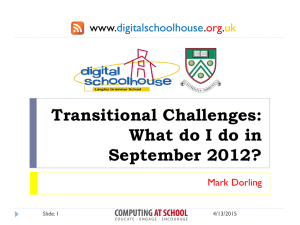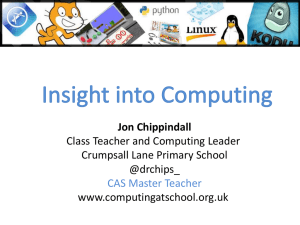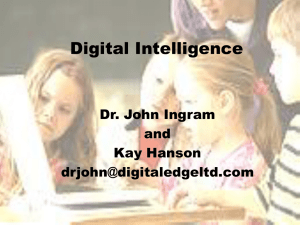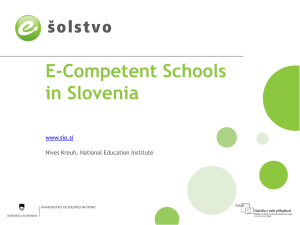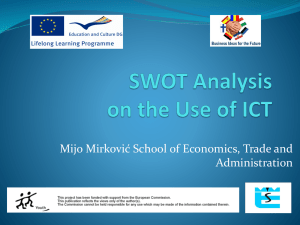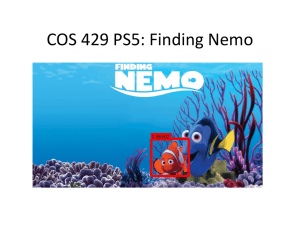Slides - Computing At School
advertisement
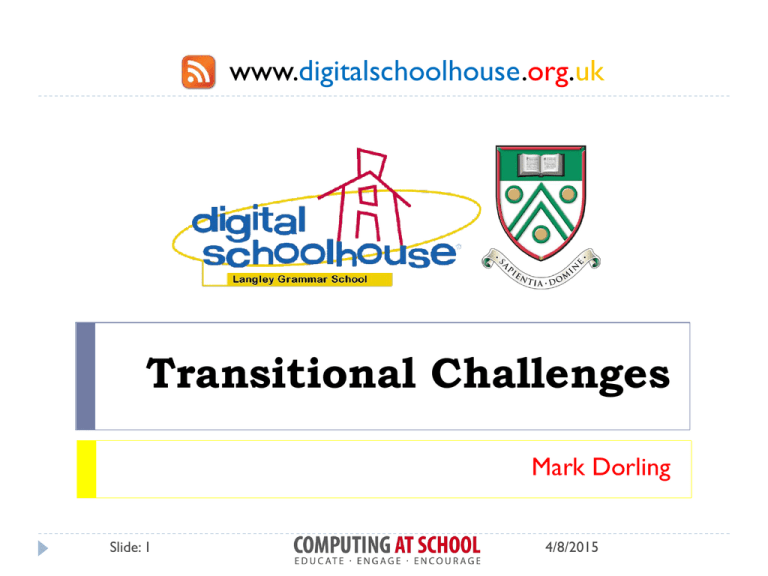
www.digitalschoolhouse.org.uk Transitional Challenges Mark Dorling Slide: 1 4/8/2015 Transition Definition “Passage from one form, state, style, or place to another.” http://www.thefreedictionary.com/transition Why is managing transition important? Year 7 dip What are the transition issues? Slide 2 Subject knowledge Structures & support Teaching style Technology 24/06/2011 Managing transition How to overcome the challenge Liaising with feeder school staff Teacher exchange program CPD on the primary curriculum Improving transition Transition days (The Digital Schoolhouse model) Transition lessons Transition lessons at the start of the year Transition lessons at the start of each unit of study It’s not what you are selling, it’s how you sell it! Slide 3 24/06/2011 Transition days Resource on CD Slide 4 4/8/2015 What… facilities 31 networked PCs Interactive White Board (IWB) Visualiser (Digital version of an OHP) Fully inclusive learning environment Larger keyboard Roller ball mouse enlarged 20” flat screen Wireless keyboard and mouse Independent learning videos Headphones with text-to-speak VLE access Fictional VLE for pupils during the lesson Langley Grammar School’s VLE for teachers pre/post visit Industry principles Slide 5 Network based PC reimaging 4/8/2015 Example of CPD: Primary curriculum Resource on CD Year 2 Slide 6 Year 4 Year 5 Year 6 4/8/2015 Algorithms & Programming Key Stage 1 – Year 1/2 Instructions (f, b, l, r) Recognise sequence instructions Recognise repeat instructions BEEBOTS / LOGO Image source: http://www.semerc.com/semerc/curriculum-strategies/design-technology/bee-bot.html Image source: http://www.mathsnet.net/logo/turtlelogo/index.html Slide 7 4/8/2015 Algorithms & Programming Key Stage 2 – Year 4 Same language used for screen turtle and a floor turtle Use pendown and penup Use the repeat command Grouped instructions can be named Combine procedures by naming named procedures Slide 8 ROBOMIND / PROBOTS Image source: http://www.keepad.com/robots.php Image source: http://www.robomind.net/en/index.html 4/8/2015 Algorithms & Programming Key Stage 2 – Year 5 Accuracy of instructions Sequence of instructions is a procedure Write a procedure to control outputs Write a procedure to solve a problem Test instructions and modify them Slide 9 CS4FN / ROBOMIND 1 1 Image source: http://www.robomind.net/en/index.html 4/8/2015 Algorithms & Programming Key Stage 2 – Year 6 Difference between timed events and caused events Inputs relate to cause and effect If, Then and Else effect output Write a procedure using wait with cause and effect SCRATCH / FLOWOL Image source: http://edutech.csun.edu/aln/?q=node/114 Image source: http://www.robomind.net/en/index.html Slide 10 4/8/2015 Algorithms & Programming KS3… maybe G&T KS2? Graphically model solution using a flow diagram Introduce success criteria Build a program from a number of procedures Test & refine a program Self assessment and evaluation against success criteria Explain and justify their work Slide 11 VARIETY Image source: http://edutech.csun.edu/aln/?q=node/114 Image source: http://www.robomind.net/en/index.html Image source: http://www.dataharvest.co.uk/ 4/8/2015 Image source: http://www.flowol.com/ How many people drive a car? Image source: http://www.news-gate.info/tag/jay-and-silent-bob/ Slide 12 4/8/2015 How many people design cars? Video source: http://www.youtube.com/watch?v=_ve4M4UsJQo Slide 13 4/8/2015 Focus on pedagogy Active Excel Human databases Human internet Human robots Card trick Slide 14 24/06/2011 Enhancing pedagogy Kodu Scratch Office Suite Robomind Internet & Web Conferencing http://www.digitalschoolhouse.org.uk/staffzone/epassport/online-introduction Slide 15 24/06/2011 Developing independence https://spreadsheets.google.com/ccc?key=0Ao96IdHP4M1dFdmU25VNmQxVW1kemhMOXZTNnVZLVE&hl=en&authkey=COHBxtYO Google docs Independent learning videos Text to speak with document & hyperlinks http://www.youtube.com/watch?v=IQqFrPAoYWM Slide 16 24/06/2011 Integrated should be creative Advantages Teaching style Connecting learning Curriculum coverage Examples: Multimedia Internet Database Programming CAD/CAM Resource on CD Slide 17 24/06/2011 Database: Exemplar The cloud with a silver lining! Team work ICT Literacy Drama Science Maths Resource on CD Slide 18 24/06/2011 ROBOMIND: Exemplar Literacy Numeracy Geography Science Art ICT Details on CAS website Slide 19 or is that Control computing… 4/8/2015 SCRATCH: Exemplar P4C Literacy Numeracy Art ICT Drama Details on CAS website Slide 20 or is that Control computing… 4/8/2015 Data Harvest: Exemplar Slide 21 or is that Control computing… Art Music ICT DT Literacy 4/8/2015 Practical advice Slide 22 24/06/2011 Support available The British Computer Society ( www.bcs.org.uk ) Vital ( http://www.vital.ac.uk/ ) naace ( http://www.naace.co.uk/ ) Computing At School ( http://www.computingatschool.org.uk/ ) Local specialist The Digital Schoolhouse ( www.digitalschoolhouse.org.uk ) Computing At School Hubs Local universities e.g. Queen Mary’s, Royal Holloway CS Unplugged (http://csunplugged.org/ ) Primary Resources ( http://www.primaryresources.co.uk/ict/ict4.htm ) Slide 23 24/06/2011



